Savannah Cat Breed Information
Savannah Cat's History
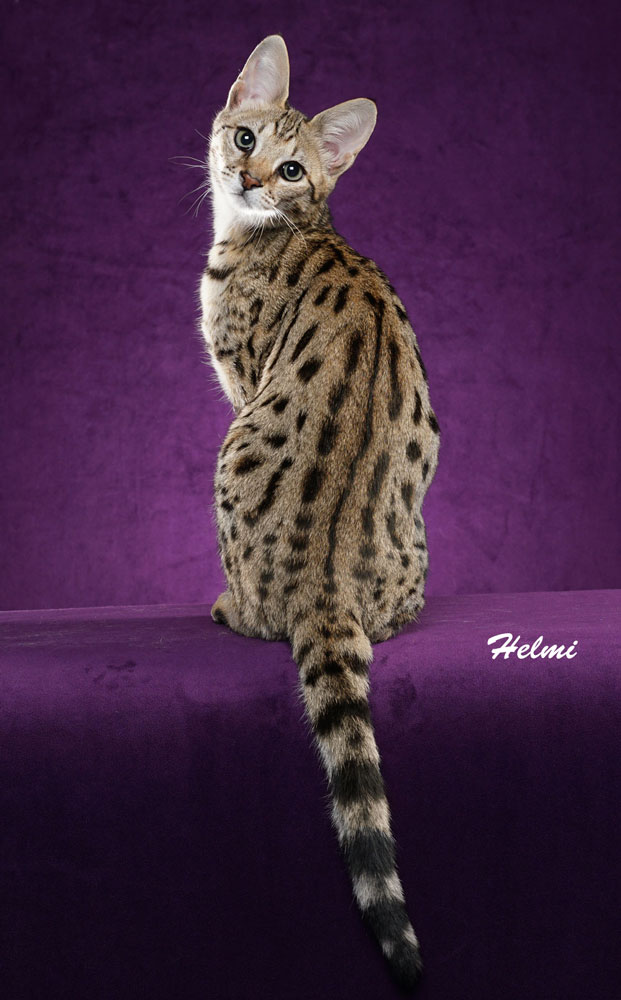
In the early 1980's, Judy Frank bred an African Serval to a domestic shorthair cat. The mating produced one female cat, later named Savannah, whom went on to produce other female kittens to establish the Savannah breed. Other breeders were impressed with the unique look and friendly, outgoing temperaments of the Savannah and went on to begin their own breeding programs. In 1996, breeders submitted an application to have the Savannah registered with The International Cat Association ( TICA) but the TICA board had placed a moratorium on accepting any new breeds. It was not until the year 2000 that the Savannah was accepted for registration. In 2002, the Savannah was unanimously accepted into show status and was shown in May of that year. The popularity of the Savannah breed has continued to grow in monumental proportions.
The Savannah Cat's ancestor, the African Serval.
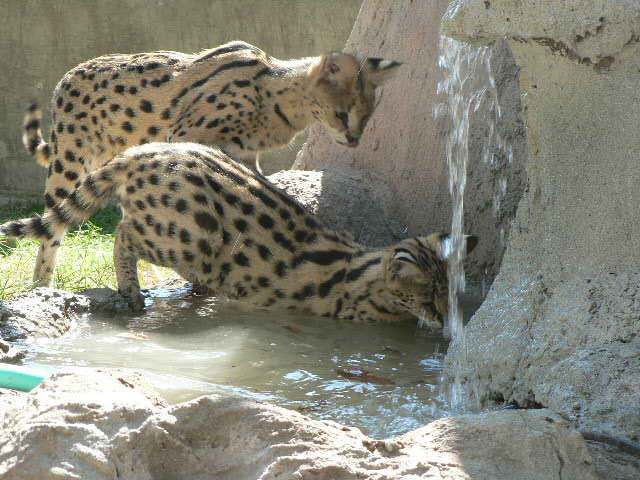
The adult Serval is a medium sized African wild cat indigenous to the savannah plains of Africa. The Serval weighs between 25 - 45 lbs. with the males on the heavier end of the spectrum. It is approx. 40 inches long including the tail and 21 to 25 inches at shoulder height. It has bold black spots on a tawny, wheat colored background. The Serval is a tall, slender cat with long legs and graceful neck. They have extremely large ears that sit high on their head. Servals are very athletic and agile. They have been known to run speeds of up to 45 mph and can jump to heights of 12 feet.
The Savannah Cat's Appearance
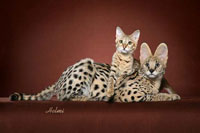
The Savannah Cat is a smaller replica of the African Serval. The Savannah Cat is a tall, lean, graceful cat with bold black spots against a luxurious background coat of golden, silver, smoke, or melanistic ( black). The exact shade and texture of thecoat, however, is directly related to the breed of cat used for the domestic outcross. The International Cat Association ( TICA) permissable outcross breeds are theegyptian mau, the ocicat, the oriental shorthair, and the domestic shorthair. Some breeders use "non-permissible" breeds such as Bengals and Maine Coons to add the spotting patterns and large size. The Savannah is considered one of the larger breeds of domesticated cats. The tall, slim build of the Savannah gives them the appearance of being larger than their actual weight. The early generation Savannahs, F1 and F2, are usually the largest, due to the strong genetic influence of the African Serval ancestor and may weigh as much as 25 lbs. A Savannah's wild look comes from the traits inherited from it's ancestor, the African Serval. One of the most distinquishing of these traits is the tall, erect ears with ocelli or 'night eye' markings, a light band of color with dark borders giving an eye-like effect. . The Savannahs have extremely long legs which contribute to their amazing jumping ability. The eyes are shades of green, gold, and brown with a slight 'boomerang' shape and are often adorned with 'tear stains' that run from the corner of the eye down the sides of the nose much that of like a cheetah.
The Savannah Cat's Temperament

Savannah Cats are unlike any other breed. They are often described as being very 'dog like' in behavior. They are very outgoing and active, loyal, and get along well with both children and dogs. They are easily leash trained and often do very well with clicker training. They show their affection by giving a "head-butt" where they literally bump heads with you. They are also extemely intelligent and curious. They quickly learn to open doors and cabinets and make a game of finding the hiding place of their favorite treats. Another unique trait of the Savannah is their love of water. They find great delight in splashing in their water bowl or in the tub.. All Savannahs have very high energy levels and are extremely curious and playful. They are also very vocal with a wide range of chirps, trills, and hisses.
The F1 Generation Savannah Cat
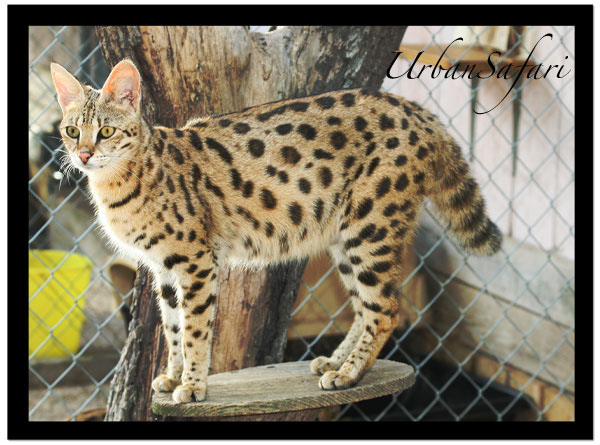
You will commonly hear of Savannahs being described as an F1, F2, etc. Each generation of Savannahs is labeled with a foundation or 'filial' number. For example, a Savannah with a Serval as a parent is an F1 and typically has 50% serval genes. The ownership of an F1 generation requires special consideration. The F1 generation, although exquisite and exotic, can be a 'handful' and are sometimes unpredictable in behavior due to the fact they retain many of the wild traits of the Serval.
The F2 generation Savannah Cat
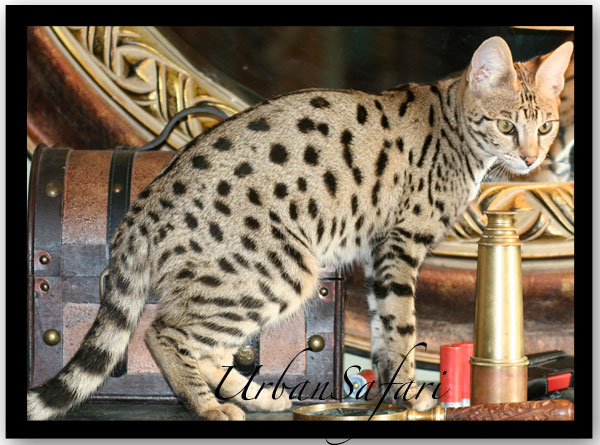
The F2 generation Savannah cat is my personal favorite. They are big, beautiful, exotic, and highly intelligent animals. They may not, however, be the ideal pet for a family with young children and/or inconsistent schedules. The F2 Savannah cats will bond very closely with their family…. they will be waiting for you at the door when you come home, follow you around the house, sleep, and sometimes even bathe with you but are not always willing recipients of the attention of ‘rambunctious’ children and/or strangers. Our F2 generation Savannah cats, at maturity, will range in height from 16-18 inches at the shoulder, about 24 inches in length , and 20-25 pound range, with males at the higher end of the scale. Our F2 Savannah cats, depending upon the sire, will have either a cool or warm gold toned base coat with vivid spotting patterns. Our F2 Savannah cats have approximately 30% serval blood.
The F3 generation Savannah Cat

The The F3 Savannah cat retains just enough wild blood to retain the exotic look and size of its wild counterpart but with a personality that is very manageable and predictable and easily adapt to most home environments. . This makes our F3 Savannah cat the most popular for busy families. They are extremely active and will keep the younger members of your family entertained for hours. My F3 Savannah cats will generally range from 15-20 pounds with males being at the top end of the scale. They have a tall, lanky body type, but are not a “ big” cats. The color of our F3 Savannah cats will vary from cool browns to golden blonde like a serval. The amount of Serval blood in our F3 generation Savannah cats is approximately 20%.
The F4 and F5 SBT generation Savannah Cat
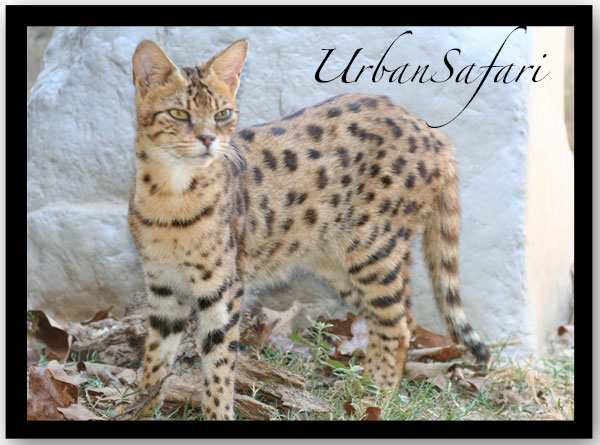
The F4 generation Savannah cat will be very similar to the F3’s in terms of color ( cool brown to golden blonde) and personality ( outgoing and interactive) but will be smaller in size and stature. They will mature at a tall, lanky 12 to 17 pounds , again, with males topping the higher end of the scale. The tall, lanky body structure makes them appear larger than a domestic cat of the same size. Our F4 Savannah cats have approx. 15% serval blood. The F4 SBT Savannah cat can now be shown as championship status with TICA (The International Cat Association). SBT status means the cat has only Savannah to Savannah breedings within 3 generations on the pedigree.